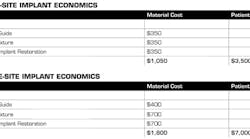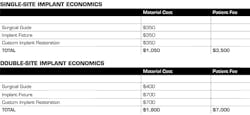By Tarun Agarwal, DDS, PA
Why have certain practices thrived during the past few years while others have just survived?
The answer is quite simple. Scope of services. The days of being able to focus on being a restorative dentist are coming to an end.
Modern practices that thrive are practices that offer a scope of services to their respective patient base. These practices, instead of focusing solely on new-patient numbers, focus on adding services to the existing patient base.
Today, we see a tremendous shift toward general dentists providing complete dental implant therapy -- both surgical and restorative. I envision a day in the near future when general dentists will place nearly 75% of all single-tooth implants.
This article will expand on the economics of digital implantology. Why digital implantology? Because it's safe, predictable, efficient, and minimally invasive.
So what's needed to provide digital implant placement? Patients, technology, implant equipment, and desire.
Patients
Here's some great news! I do not really believe that most dentists have given thought to the unbelievable potential of implant dentistry within our practices. The math is astonishing.
Let's take a typical general practice with one dentist and two hygienists working four days per week and 48 weeks per year. Between them, they will see about 90 patients per week. Of these 90 patients, about half will be missing at least one tooth (not counting wisdom teeth). So this is 45 missing teeth each week or about 2,160 a year.
If you have just 1% of these patients agree to implant treatment, that's 21 implants per year. At $3,500 per implant (placement and restorative), this results in $73,500 per year in production. If you have just 5% of the patients agree to implant treatment, this results in 108 implants per year or about $378,000 in production.
My point in this example is that it only takes a 2% to 3% acceptance rate to make a tremendous impact on a practice. Approach the 4% to 7% mark, and the impact is staggering.
More importantly, this impact comes without any fancy external marketing. It comes from simply asking each patient who is missing a tooth in your practice something such as, “Mrs. Jones, have you given any thought about your missing tooth?”
Don't forget. Getting acceptance from existing patients is much easier than gaining trust and acceptance of new patients. The bottom line is that patients are not and should not be the holdup. There are more than enough patients within your practice.
Technology and Equipment
The most common objection to adding dental implants to your service mix is the fear of implant placement. Whether it's the fear of hitting a nerve, invading the sinus, hitting adjacent roots, or incorrect placement, these fears are legitimate and do have consequences.
The great news is that there is a way to alleviate much of this fear.
Guided surgery allows you to place the implant with confidence of avoiding vital structures and getting it in the right location to greatly diminish this fear. Guided surgery is based on virtual planning from a 3-D radiograph of the patient's jaw.
I am a staunch advocate of 3-D imaging and guided surgery because they give the dentist confidence to place routine single-tooth implants and allow a visual presentation to patients that increases case acceptance. When combined with continuing education and experience, this confidence can grow from single-tooth implants to more complex implant treatment in time.
Modern 3-D CBCT imaging has become more ergonomic and affordable. Gone are the days of lay-down machines and the need for large lead-lined rooms. In fact, most 3-D CBCT machines are about the size of panoramic machines.
The investment for this technology varies based on the manufacturer and the bells and whistles. But typically it ranges between $85,000 to $175,000 or about $1,500 to $3,500 per month.
When you add in the tax advantages, the cost of the technology suddenly is within reach of many practices. In fact, nearly 80% of all 3-D CBCT machines sold in the U.S. are to general dentists. The majority of these are solo practitioners.
To perform guided surgery, you will need a surgical guide and a guided surgery drill kit. Surgical guides vary in cost depending on manufacturer and complexity. But typically they range from $250 to $600. A single-tooth implant guide averages about $350. The guided surgical kit averages around $8,000; however, this initial outlay can often be offset -- or in some cases -- eliminated with the purchase of dental implants.
Dental implant fixtures can vary widely in cost from $100 to $450 based on use of a name-brand implant versus a compatible implant, as well as the quantity of implants purchased. It has been my experience that service and support have been commensurate with the cost of the implant. For those who are just beginning their implant journeys, it is wise to stick with the larger implant companies.
Dental implants can be done without all this technology, but digital implantology opens the door for more dentists to get in the game. It alleviates much of the fear associated with placement, shortens the surgery appointment, decreases patient discomfort, and increases patient acceptance.
Digital Implant Economics
Let's take a look at a couple of real-world examples of the economics of implant placement. For these examples, the average patient fee will be $3,500, inclusive of surgical and restorative phases. We will assume that no grafting or preimplant surgeries are required. This scenario represents more than half of all implant procedures being done in my practice today.
In the example of the single-implant site, there is a gross profit of $2,450. In the example of two implant sites, there is a gross profit of $5,200. Using this economic logic, a practice needs to do one implant per month to justify the cost of 3-D imaging technology and guided surgery. This is only 12 implants per year or just more than 0.5% case acceptance in the typical general practice.
Desire
Just a few years ago, our practice did zero dental implants. Today, thanks to 3-D imaging technology and continuing education, dental implants are a key and routine part of our general practice. The best part is that the vast majority of the implants we place come from within our hygiene department or direct patient referrals. We do this without external marketing.
I realized several years ago that being a restorative dentist was not enough to thrive. It is imperative that a practice continues to improve and expand its clinical capabilities. There is no shortage of patients who could benefit from or desire dental implants. I have relied on 3-D technologies to make implants more attainable, predictable, safe, and profitable for my practice. I encourage you to do the same.
Tarun Agarwal, DDS, PA, is a nationally recognized educator in the field of digital esthetic and implant dentistry. He offers general dentist-specific implant training using modern digital technologies that make implant dentistry safe, predictable, and profitable. Reach him via email at [email protected].
Past DE Issues







